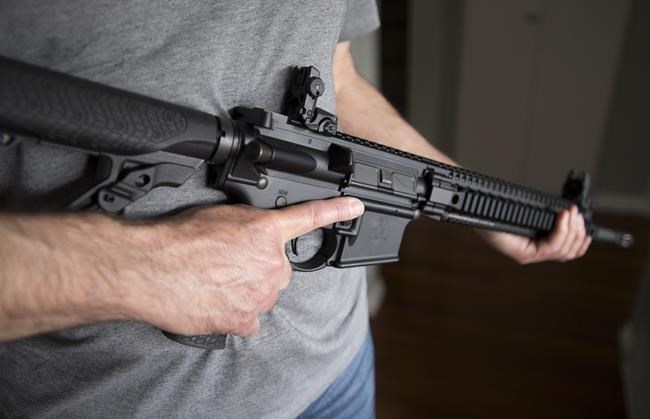OTTAWA — A professor who has closely tracked the history of gun control says the Liberal government's latest moves could make Canada's complex firearm classification system even more complicated.
The government is proposing a ban on assault-style firearms that would apply once legislation now before Parliament comes into force.
The definition would include a firearm that is not a handgun that discharges centrefire ammunition in a semi-automatic manner, and that was originally designed with a detachable magazine with a capacity of six cartridges or more.
But the ban would not apply retroactively.
Blake Brown, a historian at St. Mary's University in Halifax, says that means many currently available firearms won't be prohibited even though they could meet the definition of an assault-style gun applied down the road.
Brown said the approach clashes with the Nova Scotia mass shooting inquiry's recent recommendation to ban all guns, not just some, that meet such criteria.
"If you're saying, well, we're only going to treat new weapons that come into the market as prohibited, that's not treating them all the same," he said in an interview.
"Critics have long said we have a bit of a patchwork of a system. This new system is going to take that patchwork system and probably make it worse. To that extent it's a bit concerning."
The Liberals have been working behind the scenes in recent days to secure support for the new proposal from the NDP and Bloc Québécois.
Members of the House of Commons public safety committee began discussing the revised definition of assault-style guns Tuesday, asking federal policy officials to explain the wording and its scope.
Conservative MP Doug Shipley said the planned definition was vague. "You could drive a dump truck through that wording."
Beyond the halls of Parliament, voices on either side of the federal push to legislate additional controls on firearms agreed that the latest approach would not bring greater certainty and clarity to the system.
"What happens if you are pulled over while in possession of a centrefire firearm purchased prior to this definition coming into force?" the Canadian Shooting Sports Association asked in a note to members about the proposal.
"Police forces are already challenged to know what category a firearm falls into under the current classification system. Adding a date component only further muddies the waters for law enforcement," the association said.
"It's possible that police would charge you and let the courts sort it out — in essence using the process as the punishment."
Heidi Rathjen, co-ordinator of gun-control group PolySeSouvient, said Tuesday the planned definition "just adds more confusion to the classification system because it only applies to future models, meaning there is a contradiction from the outset."
"Current weapons that fall under the definition remain legal. And in terms of future models, it's also a very tenuous definition because it depends on the mindset of the designer, something only manufacturers control and therefore can manipulate."
The Liberals withdrew a gun bill amendment in February that would have spelled out in law the various models to fall under an assault-style firearm ban.
They had touted the definition as an evergreen measure that would enshrine in legislation a May 2020 regulatory ban of some 1,500 firearm models and variants, including the AR-15, as well as 482 others flagged subsequently.
The government pulled the measure after weeks of criticism from Conservative MPs and some firearm advocates who said the definition would prohibit many commonly used hunting rifles and shotguns, unnecessarily penalizing gun owners.
Under the federal proposal announced this week, the government would make regulations through the Firearms Act to ensure that guns are classified correctly before entering the Canadian market.
However, that would not apply 482 models left out of the 2020 regulatory ban.
The government plans to revive a firearms advisory committee of interested groups and individuals that will make recommendations on the classification of guns now on the market.
Public Safety Minister Marco Mendicino acknowledged Tuesday that previous incarnations of the committee have not always worked smoothly.
But he said if the government can assure people "that this is not a partisan exercise, this is not about scoring political points," then it will serve an important function.
Brown said it's clear that there's already technical knowledge within the federal government about how to treat different firearms. "It's kicking things down the road to say, 'Oh, we'll listen to this body of people who we'll appoint.'"
Mendicino also pointed to government plans to update regulations regarding large capacity magazines as a means of curbing the possibility of a mass shooting.
The changes would require the permanent alteration of long-gun magazines so they can never hold more than five rounds, as well as ban the sale or transfer of magazines capable of holding more than the legal number of bullets.
This report by The Canadian Press was first published May 2, 2023.
— With a file from Mia Rabson.
Jim Bronskill, The Canadian Press



